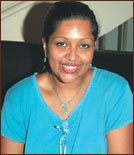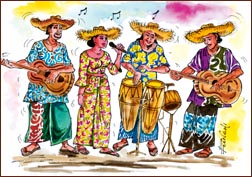
Vasana Kelum de Mel
Pic: Chinthaka Kumarasinghe
by LAKMAL WELABADA - Sunday Observer Dec 7 2003
|
|
Vasana Kelum de Mel is in Sri Lanka on a Fulbright schol doing Ph.D. in Ethnomusicology from the University of California, Los Angeles (UCLA). Her five months stay will end in March. Within that time she hopes to finish her dissertation in 'Music as symbol, Music as emissary: a study of Baila and Calypso in Sri Lanka'.
"Since Sri Lanka was colonised by three European powers, we have lot of mixes inherited from them," says Vasana.
"Baila and Calypso are the most significant influences from Portuguese, which still exist in different formats.
Though rituals and traditions of Sri Lanka have been studied and highlighted internationally, this aspect of society has not yet been featured. So I thought it would be an important as well as an interesting area to study," she said.
Vasana is the daughter of Nihal de Mel and the niece of Dulip de Silva, members of the well known 70s group 'Los Flemencos'.
 |
"I started to learn piano music from my mother from the age of five and I am still continuing," she smiled.
The de Mel family is today settled in USA. Vasana got her Bachelor of Music (B.M. - piano performance) from the University of Colorado, Boulder in USA in 1994. And in 1998 she got the M.A. in Ethnomusicology from the University of California, Los Angeles (UCLA) where she continues with her Ph.D.
Ethnomusicology
Vasana was employed as a lecturer at the UCLA since 1996, on completion of her B.M.degree "Ethnomusicology is essentially a study of folk music of non-western cultures. This was started as a subject for the first time in the UCLA itself in 1953. Recently it branched out to include popular music comprising the in-between musical chords like 'Baila and Calypso'," she explained.
"I felt this would be an interesting subject because if you put 'Baila and Calypso' on a slide and magnify them on a microscope you will see a microcosm of Sri Lankan society at the historical, political and cultural level," she said.
Vasana's research is divided into three spheres. They are 'Manja', the Baila custom found in the Kaberi community in Sallan Kandal colony in Puttalam; 'Vada Baila'(debate Baila) custom found in the southern area ; Mount Lavinia, Lakshapathiya - Moratuwa and Panadura; and Chorus Baila which is more commonly found in the popular entertaining field in Sri Lanka,
"The most moving information I gathered for my study comes from 'Manja', which emerged from the Kaberian community. Their ancestors were brought down to Sri Lanka in the capacity of slave labourers by the Portuguese in 1500 and then the British in 1800.
Customs
Though mixed with other Sri Lankans from time to time this community still gets marginalised from the rest of society.
But they still treasure their customs especially their musical chords and dancing steps inherited from Portuguese.
They still live in underprivileged conditions.
And if one wants to write about them it would be another full feature!" said Vasana.
About Chorus Baila, Vasana said that 'The Gypsies' are in the forefront. "And the credit of bringing all the novel ideas to the entertainment field in the Sinhala 'Baila' music industry of this country should be given to 'Gypsies' leader Sunil Perera. Since I feel it is an essential issue to study the 'gender Baila' as well, the work of the female Baila singers like Mariazelle Goonetilleke and Corinne Almeida should also be appreciated," she said.
Vasana points out that the Latin American and Caribbean music is fading away from the places of its origin. "But, it is still alive and well preserved in some of the former colonies of those countries like Sri Lanka and Goa (India)".
Why is that?
"That's what I want to find out," she said. Vasana hopes to continue her research on the same subject in Goa, Malaysia and Singapore where the Latin American influence is still evident.
"Also I hope to do a full study from Buddhist Pirith chanting to local folk music in the future," she concluded.